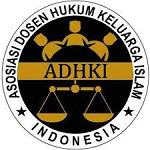Marriage with the Transfer of a Nasab Guardian to Teungku Dayah According to Islamic Law (Case Study in Ingin Jaya District, Aceh Besar Regency)
Pernikahan Dengan Peralihan Wali Nasab Kepada Teungku Dayah Menurut Hukum Islam (Studi Kasus Di Kecamatan Ingin Jaya Kabupaten Aceh Besar)
DOI:
https://doi.org/10.22373/hadhanah.v3i2.1698Keywords:
Marriage, Nasab Guardian, Teungku DayahAbstract
This research was motivated by a case in the Ingin Jaya District, Aceh Besar Regency, where there was a marriage with the transfer of the nasab guardian to Teungku Dayah in accordance with Islamic law. A wakalah or transition contract is essentially a contract used by someone if the guardian of the nasab marriage needs someone else to do something that he cannot do himself and asks someone else to do it with the consent of both parties. Therefore, the researcher is interested in researching what factors led to the transfer of marriage guardianship from the nasab guardian to Teungku Dayah and what Islamic Law provisions mean for the process of transferring the nasab marriage guardian to Teungku Dayah. The research methods used are field research and library research. The results of the research state that provisions in Islamic law allow transition or representation to Teungku Dayah due to various factors including ungodly abandoning Allah SWT commands such as abandoning obligatory prayers, carrying out Allah SWT prohibitions such as disobedience, gambling, nervousness or embarrassment in public, old age such as being senile, his eyes are blurry, and his body is shaking. Furthermore, the view of Islamic law regarding the process of transferring the guardian of the nasab marriage to Teungku Dayah is a process that must be gone through, namely that the guardian of the nasab and the person who replaces the position of guardian of the nasab must carry out a wakalah contract before the marriage takes place. The legal transition was carried out because it was seen as a form of mutual help based on goodness and piety commanded by Allah SWT and His messenger.
References
Abdul Ghofur Anshori, Wakalah, Yogyakarta: Gajah Mada University Press, 2010.
Abi Ahmad Ibn Al-Husain Ibn Ali Al-Baihaqi, Sunan Al-Kubra, Juz 7, Bairut: Dar al-Kutub Al- ‘llmiyah, 1999.
Abul Hidayah, Fathul Mu’in, Surabaya: al-Hidayah, 2001.
Ali Ibnu Umar ad-Daruqudni, Sunan ad-Daruqudni, Beirut: Dar al-Fikr, 1994.
Amir Syarifuddin, Garis-Garis Besar Fiqh, Jakarta: Prenada Media, 2003.
Amir Syarifuddin, Hukum Perkawinan di Indonesia, Jakarta: Kencana, 2011.
Andi Prastowo, Metode Penelitian Kualitatif, Yogyakarta: Ar-Ruzz Media, 2011.
Hamid Sarong, dkk, Fikih, Banda Aceh: Bandar Publishing, 2009.
Hamid Sarong, Hukum Perkawinan Islam di Indonesia, Cet. 3, Banda Aceh: Yayasan Pena, 2010.
Ibnu Rusyd, Bidayatul Mujtahid Wa Nihayatul Muqtashid, Jakarta: Al- Kautsar, 2016.
Ibrahim al-Bajuri, Hasyiyah Albajuri, Bandung: Syirkah al-Ma’arif, 2007.
Mardani, Hukum Keluarga Islam di Indonesia, Jakarta: Kencana, 2016.
Moh. Amrullah, Fikih, Bandung: CV Armico, 1994.
Muhammad Hasby Ash-Shadigi, Hukum-Hukum Fiqih Islam, Bandung: Sinar Baru Algensindo, 2016.
Muhammad Syafi’i, Wakilah, Jakarta: Gema Insani, 2001.
Saifuddin Arief, Notariat Syariah dalam Praktek, Jakarta Selatan: Darunnajah Publishing, 2012.
Sayyid Sabiq, Fikih Sunnah 2, Jakarta: Cempaka Putih, 2008.
Sayyid Sabiq, Fiqih Sunah 7, Bandung: Al-Ma-arif, 1990.
Sohari Sahrani, Fikih Munakahat, Jakarta: PT Grafindo Persada, 2010.
Sulaiman Rasjid, Fiqih Islam, Bandung: Sinar Baru Algensindo, 2016.
Wahbah Zuhaili, al-Fiqh al-Islam wa Adillatuha, (Terj: Abdul Hayyie al- Kattani, dkk), Jilid 9, Jakarta: Gema Insani, 2011.
Wahbah Zuhaili, Fikih Imam Syafi’i, Jakarta: Almahira, 2008.
Zulfi Diane Zaini, Implementasi Pendekatan Yuridis Normatif dan Pendekatan Normatif Sosiologis dalam Penelitian Ilmu Hukum, Jurnal Pranata Hukum, Vol. 6, No. 2, Juli 2011.
Downloads
Published
How to Cite
Issue
Section
License
Copyright (c) 2023 Maghfirah Maghfirah

This work is licensed under a Creative Commons Attribution 4.0 International License.

















